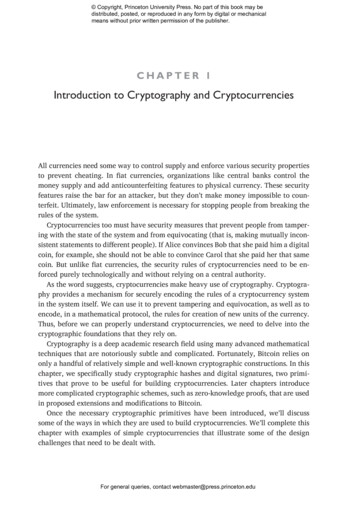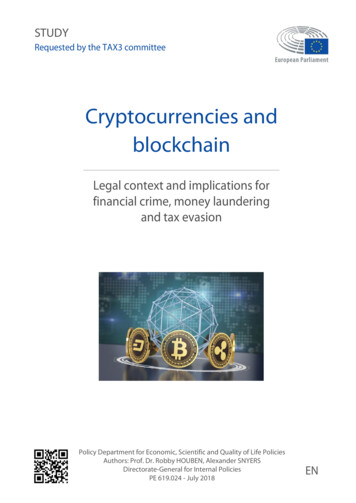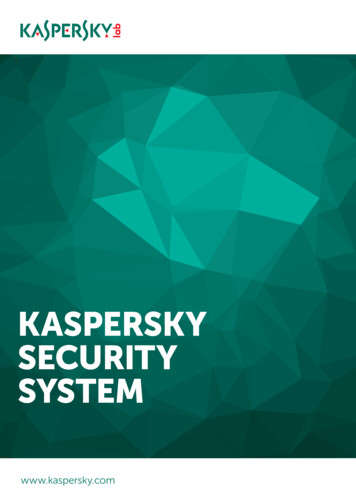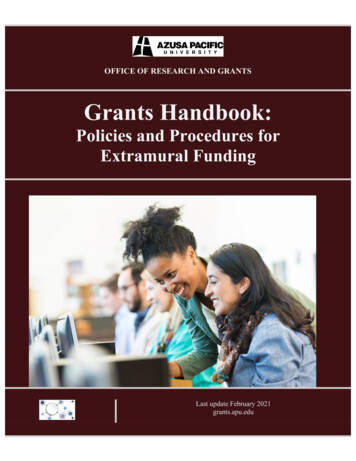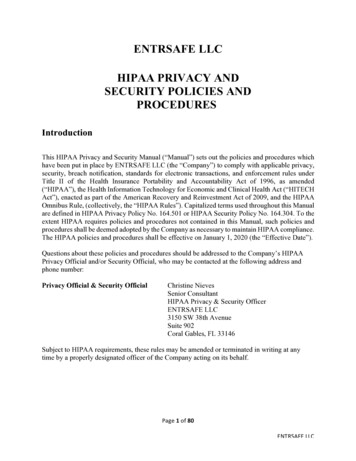
Transcription
Cryptocurrencies with Security Policies and Two-Factor AuthenticationFlorian Breuer Vipul GoyalGiulio Malavolta KITNTT Research and CMUMPI-SPAbstract—Blockchain-based cryptocurrencies offer an appealing alternative to Fiat currencies, due to their decentralized and borderless nature. However the decentralizedsettings make the authentication process more challenging:Standard cryptographic methods often rely on the ability ofusers to reliably store a (large) secret information. Whathappens if one user’s key is lost or stolen? Blockchainsystems lack of fallback mechanisms that allow one torecover from such an event, whereas the traditional bankingsystem has developed and deploys quite effective solutions.In this work, we develop new cryptographic techniquesto integrate security policies (developed in the traditionalbanking domain) in the blockchain settings. We proposea system where a smart contract is given the custody ofthe user’s funds and has the ability to invoke a two-factorauthentication (2FA) procedure in case of an exceptionalevent (e.g., a particularly large transaction or a key recoveryrequest). To enable this, the owner of the account secretshares the answers of some security questions among acommittee of users. When the 2FA mechanism is triggered,the committee members can provide the smart contractwith enough information to check whether an attempt wassuccessful, and nothing more.We then design a protocol that securely and efficientlyimplements such a functionality: The protocol is roundoptimal, is robust to the corruption of a subset of committeemembers, supports low-entropy secrets, and is concretelyefficient. As a stepping stone towards the design of thisprotocol, we introduce a new threshold homomorphic encryption scheme for linear predicates from bilinear maps,which might be of independent interest.To substantiate the practicality of our approach, we implement the above protocol as a smart contract in Ethereumand show that it can be used today as an additional safeguard for suspicious transactions, at minimal added cost. Wealso implement a second scheme where the smart contractadditionally requests a signature from a physical hardwaretoken, whose verification key is registered upfront by theowner of the funds. We show how to integrate the widelyused universal two-factor authentication (U2F) tokens inblockchain environments, thus enabling the deployment ofour system with available hardware.1. IntroductionBitcoin and blockchain-based cryptocurrenciesbrought us at the brink of a technological revolution:These systems allow us to bypass the need for centralizedtrusted entities to run currencies on a large-scale. While Workdone in part while at CMUtheir decentralized and borderless nature make themappealing substitutes for Fiat currencies, a burningproblem with this approach is the lack of a recoverymechanism if something goes wrong. What happens ifone user’s key is lost or stolen? There is no bank tocall and no authority to rely upon to get your fundsback. Indeed, the number of such high profile attackson cryptocurrencies has been rising steadily. Famousincidents like the Mt. Gox hack [14], the coincheckhack [2], and the Parity Technology code deletion [3]saw funds upwards of several hundred million dollarsbeing lost or stolen. The well-known DAO hack [32]forced Ethereum to adopt a hard fork which createdtwo version of the currency: Ethereum and Ethereumclassic. To deal with such problems in future, Ethereumdevelopers have proposed EIP 867. An ethereumimprovement protocol (EIP) is the process by whichcode changes get accepted onto the Ethereum platform.However EIP 867 has proven to be controversial since itwill again bifurcate the currency into two versions, thevery problem it was trying to solve.The problems of attackers stealing money or losingcredentials are of course not unique to blockchain-basedcryptocurrencies. The (traditional) banking industry hasbeen dealing with such issues for decades where a numberof mitigating approaches have worked pretty effectively.Examples of common security policies to deal with suchattacks include: A waiting period (say 24 hours) fortransferring money to a new recipient and an overall dailyoutgoing transfer limit. Bypassing these restrictions couldeither require additional verifications (such as two-factorauthentication), or may not be allowed at all. Differentbanks could follow different security policies which mightalso vary depending on the type of account (business vspersonal) and by the state/region and the local laws. Thismotivates the following question:Can we take the lessons learnt in the traditionalbanking domain, and apply them fruitfully toblockchain-based systems, without compromising their decentralized nature?1.1. System ArchitectureWe propose a system where each user has the opportunity to delegate the custody of its funds to a smart contract.The security policy (which can be specified by the useritself) is hardwired in the smart contract and it governs itsdecision. All funds transfer will go through the approvalof such a smart contract, which has the power to acceptor reject (or even set on hold) each transaction, dependingon the specified policy. In case of an exceptional event,such as key theft, or as an additional security safeguard
in case of particularly large transactions or transactions tonew addresses, the smart contract will require additionalverification via two-factor authentication (2FA). We stressthat one does not need to authenticate all transactions butonly a carefully chosen set, at the discretion of the policyspecified by the owner of the funds.In this work we implement the above idea by developing solutions for 2FA mechanisms that can coexist withthe decentralized nature of blockchain-based currencies.To be aligned with the philosophy of decentralized system,our solutions are guided by the following design principles.Distributed Trust. The 2FA must not rely on the existence of a trusted authority. Instead we propose toleverage a hardware token or distribute the trust amonga (reasonably-sized) set of parties, which are asked to intervene in case of exceptional event. The members of sucha committee can be chosen by the users or can be selectedthrough a consensus protocol (e.g., the miners themselvescan play this role). Security must be guaranteed even if asubset of the committee members behaves maliciously.Reliability and Guaranteed Output Delivery. We require the 2FA mechanism to be resilient against (benign)disconnections and (malicious) denial of service attacks.That is, even if part of the members of the committee gooffline or become corrupted, one should still be able tocomplete the authentication procedure (given that the setof online parties is large enough).Low Latency. In distributed environments communicationis typically expensive, as messages have to be broadcastedto all users in the network. For this reason it is of centralimportance to minimize the rounds of communication ofa 2FA mechanism.Computational Efficiency. General purpose cryptographic solutions are very powerful but are often computationally intensive. We aim to build a solution basedon well-established cryptographic components which isefficient enough to be integrated in real-life systems.1.2. Two-Factor Authentication MechanismsA popular approach to 2FA in the traditional bankingsystem is that of security questions: When the 2FA istriggered, the user is prompted to answer a personalquestion and the verification process succeeds if the user’sanswer is correct. If we were to import this idea to thedecentralized setting, the first question that arises is whereto store the correct answers in absence of a trusted authority. Clearly the smart contract cannot hardwire the correctanswers as otherwise they would be public knowledge(smart contracts do not offer any form of privacy). Sinceanswers typically come from a low-entropy distribution,storing the hash of them is also not a good idea sinceit is vulnerable to off-line dictionary attacks, where anattacker recovers the hash and tests locally his guessesuntil he succeeds.Our idea to bypass this obstacle is to secret share thecorrect answers among a set of n parties, in such a waythat stealing the secret would require to corrupt at least tmembers of this committee (for some threshold parametert n). When the 2FA mechanism is triggered, the useris asked to authenticate its transaction τ by providing thecorrect answers to a set of predefined questions. The userthen broadcasts a message to all committee members, whoperform some computation locally and output a partialresponse tied to the transaction τ . The smart contractthen collects sufficiently many responses and publiclychecks whether the authentication was successful. If thisis the case the smart contract allows τ to go through,otherwise it rejects it. In terms of security, we requirethat the above process does not reveal anything beyondwhether the user’s guess was correct or not, even if theattacker corrupts a certain subset of committee members.Henceforth, we refer to this procedure as a distributedzero-tester (DZT).1We also consider an alternative setup where we leverage a physical two-factor authentication token. As anexample, universal two-factor authentication (U2F) tokensallow a user to sign any message by querying the token.With this tool at hand, authentication is done as follows:The smart contract hardwires the verification key of theU2F token and, when the 2FA mechanism is invoked,sends the user a nonce. The authentication is successfulif the user provides a correct signature on the nonce.1.3. Security PoliciesOur system is completely flexible in the policy that isenforced by the smart contract, which can be specified bythe owner of the address. A more conservative usage ofour system is just as an additional safeguard mechanism:Suspicious transactions (e.g., unusually large amounts ortransactions to a new address) can trigger the 2FA mechanism and force the user to provide (human-memorable)answers to some security questions or a signature froma physical token. This gives an additional line of defenseeven against the catastrophic event where an attacker stealsa user signing key.On the other side of the spectrum, one user maywant to set the policy such that some transactions areallowed given only the 2FA, i.e., they are not required tobe digitally signed. This can be useful in scenarios wherea user has lost the signing key for an address and wantsto recover the funds: Answering some security questionsallows him to transfer the coins to a fresh address (witha newly sampled signing key). However this liberal usageof our system requires careful thoughts. While on the onehand it improves the usability of the currency, on the otherhand it opens the doors to a new attack vector: insteadof stealing a secret key, an attacker can compromisethe address by guessing the answers to some securityquestions (or stealing a physical token), which is typicallya much easier task. This risk can be mitigated by ratelimiting the amount of attempts for unsigned transactionsto, e.g., once per week. Since each attempt requires theuser to post a message over the blockchain, the querylimit can be enforced by the smart contract itself, withoutthe need for the committee members to coordinate or toupdate the code of the physical token.In this work we mainly focus on the former case,where the 2FA mechanism is invoked in addition to thestandard digital signature check. An in-depth cost analysis1. The name comes from the fact that the committee members canjointly check whether an attempt α̃ corresponds to the correct answer α(i.e., α̃ α 0) and nothing beyond that.
of the security and usability tradeoff of unsigned transactions is beyond the scope of this work.1.4. Our ContributionIn this work we propose a new method to safeguardtransactions on blockchain-based cryptocurrencies, inspired by the solutions developed in the (traditional) banking domain. We then develop 2FA mechanisms amenableto the decentralized nature of cryptocurrencies, offeringdifferent trade-offs in terms of trust assumptions, physicalcapabilities, and computational efficiency. Our technicalcontributions can be summarized as follows.(1) Definitions. We develop the notion of distributed zerotester (DZT), the central cryptographic building block thatenables efficient 2FA in decentralized system. We giveformal definitions (Section 5) for this primitive and wecharacterize the security requirements with a game-baseddefinition.(2) Cryptographic Protocol. We propose a cryptographicinstantiation of DZT from standard assumptions on bilinear groups (Section 6). The scheme is round optimal,has guaranteed output delivery, and is concretely efficient.Along the way, we develop a new threshold homomorphic encryption scheme for linear predicates from bilinear groups (Section A), which might be of independentinterest.(3) Implementation. We implement the DZT scheme as asmart contract in Ethereum (Section 7). Our performanceevaluation shows that, for reasonably-size committee, theresulting 2FA mechanism can be deployed by today’susers at minimal additional cost (around 1 per authenticated transaction). We also implement a U2F-based 2FAmechanism as a smart contract in Ethereum (Section 8),thus enabling 2FA with a hardware token already available to the public. In terms of added cost, our schemeintroduces (approximately) an additional 3 to 28 pertransaction, depending on the choice of the curve.2. Technical OverviewIn the following section we give an informal exposition of the techniques developed in this work. We focuson the main goal of designing a crytpographic solution fora DZT: In a DZT a client secret shares an answer α (theprimitive naturally extends to the settings of multiple answers) among a set of n parties. When the 2FA is invoked,the client (which has an attempt α̃ in his head) crafts asingle query q and sends q (together with the transactionidentifier τ ) to all parties, who locally compute a responsepi . Given a large enough set of responses {pi }i S , forsome set S of size S t, anyone can publicly determinethe outcome of the authentication process. The transactionτ is successfully authenticated if and only if α α̃ and theprotocol should not leak any information beyond whetherthe authentication process succeeded or not.2.1. A Generic SolutionWe first discuss a high-level idea of our solution andthen we present an efficient cryptographic instantiation.Threshold fully-homomorphic encryption [22], [11] allows us to compute any function over encrypted data andoffers a general solution to our problem: The client cansimply compute Enc(pk, α) and distribute the shares of thesecret key (sk1 , . . . , skn ) to the committee members. Toauthenticate a transaction, a user computes Enc(pk, α̃) andbroadcasts it to all parties. Then the committee memberslocally compute, using the homomorphic properties of thescheme, ?c Enc pk, α α̃and compute and output the partial decryption using theirshare ski . The plaintext bit {0, 1} of c can be publicly reconstructed using a large enough set of decryption sharesand the output of the authentication is set to be this bit.While this solution satisfies all of our security requirements, it introduces a prohibitively high computationaloverhead. As of today, implementing a generic fullyhomomorphic encryption in an Ethereum smart contractis far off the reach of the current infrastructure. Thus,developing a solution that can be used in today’s systemsrequires us to devise a different strategy.2.2. A Flawed AttemptIn order to understand our solution, it is instructiveto iterate through a simple construction and analyze itspitfalls. In the setup phase, the client samples an ElGamal [18] key pair (x, h g x ) and encrypts the answer αunder such a key, making the resulting ciphertext(c0 , c1 ) (g r , hr · g α )publicly available to all parties. The secret key x is thensecret shared (using Shamir scheme [36]) among n partiesin such a way that any t shares are sufficient to reconstructthe secret. Let (xi , i) be the i-th share. To authenticationa transaction τ , a user can compute the encryption of itsattempt(d0 , d1 ) (g s , hs · g α̃ )and broadcast it to all members of the committee. Eachparty then computes and broadcasts pi (c0 ·d0 )xi . Givena set S of responses, the outcome of the authentication canbe publicly recovered by checkingY?pλi i c1 · d1i Swhere λi is the i-th Lagrange coefficient. Note that ifα α̃, then c1 · d1 hr s and indeed the above equationholds true since the secret x is reconstructed in the exponent. Unfortunately this solution has multiple flaws. Firstof all, there is no mechanism that ties the transaction τ tothe authentication process so one can authenticate withoutthe knowledge of α by simply replaying a valid ciphertext(c0 , c1 ) and swapping the corresponding transaction τwith a new τ̃ . Furthermore, even if a single memberprovides a malformed answer, the entire mechanism forverification fails.While these issues can be resolved using noninteractive zero-knowledge proofs (NIZK) [7], there is amore serious problem: If the authentication is not successful, then the responses of the committee members revealsthe exact difference α α̃. This is becausehr s · g α α̃hr s · g α α̃c1 · d 1P g α α̃Qλihr sg (r s) i S xi λii S pi
which means that the attacker can always guess the correctα with at most two queries. This is a notorious issue inthreshold cryptography, and current approaches to resolvethis problem (see, e.g., [20], [17], [30]) require one toadd two rounds of interaction. This is not acceptable forus, since we consider settings where communication isexpensive (i.e., each message is posted on a blockchain)and thus we aim at a completely non-interactive solution.the factor κρ completely masks the difference α α̃ andprevents the attack as described above. Since the valueof k g κ is freshly sampled upon each attempt, the randomization factor is pseudorandom for each authenticationquery. Also note that k can be sampled locally by eachparty, without the need of any additional interaction.2.3. Bilinear Maps at RescueThe above presentation glosses over many importantaspects that need to be taken into account when buildingan efficient protocol. As an example, the above protocolmust be augmented with NIZK proofs to make sure thata malicious player cannot deviate from the specificationof the protocol. However, using generic NIZK schemesfor NP would vanish our efforts to build a practicalsystem. Fortunately we show that our scheme can beslightly tweaked to allow us to implement the requiredNIZKs using exclusively Schnorr proofs for discrete logarithm equality [35], which results in a concretely efficientscheme.Another set of challenges arises when implementingthe protocol as a smart contract in Ethereum. In order toobtain an efficient protocol, we would like to leverageprecompiled instructions to perform bilinear group operations. However the semantic of operations supportedby Solidity (the language of Ethereum smart contracts)is very limited: It only supports group operations in thesource G1 and pairing-product equation checks. This turnsout to be insufficient to implement the scheme as outlinedabove. To circumvent this issue, we further modify ourconstruction to make it fully compatible with precompiledinstructions in Solidity. This process is not hassle-free:The new scheme requires us to introduce a new (static)assumption over bilinear groups, the dual Diffie-Hellmanassumption. We then show that such an assumption holdstrue in the generic group model. We refer the reader tothe Section 6.2 sections for further details.Also the integration of a U2F-based solution inEthereum introduces some additional complications. As anexample, a smart contract cannot implement a randomizedalgorithm but we need to sample a random challenge tocomplete the U2F authentication protocol. Instead of atruly random string, we use the hash of a unique identifierof the transaction (to prevent replay attacks) to implementthe challenge sampling procedure. We elaborate in moredetail in Section 8.The above vulnerability comes from the fact that thethreshold version of ElGamal encryption does not satisfythe notion of simulation security for equality predicates,i.e., instead of revealing whether two strings are equalor not it reveals the exact difference. This problem canbe bypassed by resorting to more powerful cryptographicmachinery.Our first observation is that the class of predicatesthat we need to evaluate is very restricted, so there ishope to build a solution without the full power of fullyhomomorphic encryption. Our second observation is thatthe protocol is already secure if the authentication issuccessful, so we only need to worry about the case wherethe answer is not correct, i.e., α 6 α̃.Our central idea is to revisit the ElGamal-based approach by adding a re-randomization factor to the plaintextof the evaluated ciphertext, which cancels out only ifα α̃. This can be done with the help of bilinear groups.In a bit more detail, in the setup phase, the client publishes(c0 , c1 , c2 , c3 ) (g r , hr · g ρα , g r̃ , hr̃ · g ρ ) G41where h g x . The secret key x is secret shared asbefore. Note that (c0 , c1 ) serves the same role as before,except that there is an additional factor ρ multiplied by theanswer α. The role of (c2 , c3 ) will be clear in a moment.The authentication begins with the user computing andbroadcasting the encryption(d0 , d1 ) (g s , hs · g ρα̃ ) G21 .Note that the user does not know the factor ρ but can stillcompute a valid ciphertext for ρα̃ by obliviously raising(c2 , c3 ) to the power of α̃ and then re-randomizing theresulting ciphertext.Each committee member computes (c0 · d0 )xi as before, except that it additionally samples a fresh elementk g κ G2 using a random oracle and returnspi e ((c0 · d0 )xi , k) e(g, g)(r s)xi κ GTas the decryption share. The outcome of the authenticationprocess can be recovered by checkingY?pλi i e(c1 · d1 , k).i STo see why security is preserved even in the case of afailed authentication, observe thath(r s)κ · g κρ(α α̃)h(r s)κ · g κρ(α α̃)e(c1 · d1 , k)P Qλih(r s)κg (r s)κ i S xi λii S piso in case α α̃ the randomization factor κρ cancels outand the above equality is verified. For the case case α 6 α̃,2.4. Additional Challenges3. Related WorkIn the following we survey some related work fromthe literature.Multi-Sig Addresses. One of the most prominent approaches to safeguard accounts in cryptocurrencies is thecreation of multi-sig addresses: A secret key of a digitalsignature scheme is secret shared among multiple partiesusing a threshold scheme [24], [29], [20], [16]. Approvingtransaction requires gathering a large enough set of usersto jointly sign it. This means that compromising a singledevice is no longer sufficient to steal coins.Our approach complements this idea and adds twoimportant features: (1) Multi-sig address require to gathermultiple parties to sign every transaction regardless of
how small or big it is, whereas in our system a smartsecurity policy can decide when additional verification isrequired. To the best of our knowledge, there has beenno previous work which has this feature. (2) Our systemsupports also low-entropy secrets (e.g., human-memorablepasswords or answers to security questions) that can beused as an additional verification, in case one of the partiesloses his credentials.Password-Protected Wallets. Another approach to improve the usability of blockchain systems is the so-calledpassword-protected wallet [21], where the secret keys areencrypted using a human-memorable password. Unfortunately these systems are vulnerable to exhaustive-searchattacks where one can enumerate all plausible passwordsand attempt to recover the secret. A DZT can be used toovercome this limitation and to construct a form of distributed password-protected wallet across some committeemembers.Vaults. Cryptocurrency vaults [33] aim at disincentivizingkey theft by delaying the acceptance transactions: Oncean illegitimate transaction is placed on the blockchain,the legitimate owner has enough time to prevent thespending using an appropriate recovery key. The aim ofthis mechanism is to reduce the incentive for an attackerto steal keys, as it will likely result in no financial gain.However, it does not address the question of recoveringaccess to an account, in case of unintentional credentiallosses.Password-Authenticated Key Exchange (PAKE). Anarea which is closely related to our DZT is that ofthreshold PAKE [31], [15], where a human-memorablepassword is used to authentication a user against a setof servers, who collectively know the password but canbe individually corrupted without compromising security.The main difference with respect to our settings is thatwe do not require to exchange any key, instead we wantto tie the authentication process with a transaction chosenby the client. Additionally, we require that the outcomeof the authentication process is publicly verifiable even byexternal parties, which is typically not the case for PAKEprotocols.Zero-Testing of ElGamal Ciphertexts. One of our maintechnical innovation is a new protocol where parties canjointly test whether an ElGamal ciphertext is an encryption of 0, without revealing any additional information.While this is a well-known problem in threshold cryptography [13], known efficient solutions (see, e.g., [20],[17], [30]) are based on a commit-and-prove approach andrequire at least three rounds of interaction. In contrast,our solution is completely non-interactive: Each partybroadcasts a single message and the verification procedureis public. This is particularly suitable for settings wherecommunication is expensive, e.g., where parties exchangemessages by posting them on a blockchain.Password-Protected Secret-Sharing (PPSS). A PPSS [4]allows a user to share a secret that can be reconstructedwith the sole knowledge of a password. Recent efficientprotocols [26] can be used as a substitute for DZT inour 2FA mechanism. However, PPSS would require atleast one more round of interaction between the committeemembers and the client. In contrast, the shares in the DZTcan be verified non-interactively and without the need toset up an off-chain communication infrastructure.Distributed Point Functions (DPF). A DPF [23] (andits generalization to function secret sharing [12]) allows a set of parties to secret-share a point functionf (f1 , . . . , fn ) whose output can be recovered bythe output of the local evaluation of each parties, i.e.,f (x) f1 (x) · · · fn (x). A DZT can be thoughtas a threshold version of a DPF with a few importantdifferences: (i) In a DZT the output shares of the partiesare publicly verifiable, which is in general not the case forDPFs. Furthermore, (ii) in a DZT the output reconstructionis not restricted to be a linear function. Finally, (iii) DZTsupports the evaluation of encrypted queries, whereas ina DPF the inputs are typically public.4. PreliminariesWe denote by λ N the security parameter. We saythat a function negl(·) is negligible if it vanishes fasterthan any polynomial. Given a set S , we denote by s Sthe uniform sampling from S . We say that an algorithm isPPT if it can be implemented by a probabilistic machinerunning in time polynomial in the security parameter.4.1. Bilinear GroupsLet (G1 , G2 , GT ) be an asymmetric bilinear groupof prime order p with an efficiently computable pairinge : G1 G2 GT and let G be the generator ofsuch a group. We denote by (g1 , g2 ) the generators of thegroups G1 and G2 , respectively, and by gT e(g1 , g2 ) thegenerator of GT . In the following we recall the eXternalDiffie-Hellman (XDH) [9] and the Decisional BilinearDiffie-Hellman (DBDH) [27], [10] problems over bilineargroups.Assumption 1 (XDH). Let G be a bilinear group generator. G is XDH-hard if for all PPT distinguishers itholds that the following distributions are computationallyindistinguishable(G1 , G2 , GT , p, g1 , g2 , g1x , g1y , g1xy ) (G1 , G2 , GT , p, g1 , g2 , g1x , g1y , g1z )where(G1 , G2 , GT , p, g1 , g2 ) G(1λ )(x, y, z) Z p .andAssumption 2 (DBDH). Let G be a bilinear group generator. G is DBDH-hard if for all PPT distinguishers itholds that the following distributions are computationallyindistinguishable(G1 , G2 , GT , p, g1 , g2 , g2x , gTy , gTxy ) (G1 , G2 , GT , p, g1 , g2 , g2x , gTy , gTz )where(G1 , G2 , GT , p, g1 , g2 ) G(1λ )(x, y, z) Z p .and4.2. Non-Interactive Zero-KnowledgeA non-interactive zero-knowledge (NIZK) proof [7]allows a prover to convince a verifier about the validityof a certain statement without revealing anything beyondthat. We recall the syntax in the following.
Definition 1 (NIZK). Let L be an NP-language withrelation R. A NIZK system for R consists of the followingefficient algorithms.Setup(1λ ) : On input the security parameter 1λ , the setupalgorithm returns a common reference string crs.Prove(crs, stmt, wit) : On input the common referencestring crs, a statement stmt, and a witness wit, the proveralgorithm returns a proof π .Verify(crs, stmt, π) : On input the common referencestring crs, a statement stmt, and a proof π , the verifieralgorithm returns a bit {0, 1}.5.1. OverviewA DZT allows one to share a secret among a selectedcommittee of users in such a way that later on one canauthenticate using the knowledge of such a secret, assuming that a large enough portion of committee members isonline. Our definition for a DZT is tailored to distributedenvironments where communication is expensive and anarbitrary subset of parties may decide not to comply withthe protocol specifications. Our definitions (and consequently the instantiation that we propose) are guided bythe following design principles.Round Optimality. For our applications of i
age a physical two-factor authentication token. As an example, universal two-factor authentication (U2F) tokens allow a user to sign any message by querying the token. With this tool at hand, authentication is done as follows: The smart contract hardwires the verification key of the U2F token and, when the 2FA mechanism is invoked,
